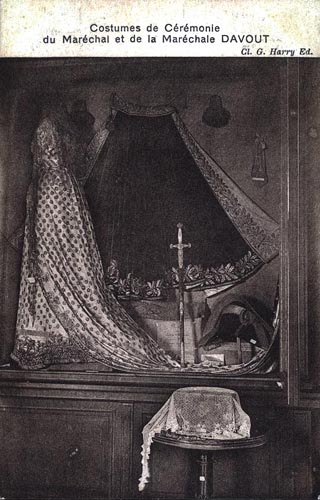|
Dress and train belonging to the wife of Maréchal Davout
| 
When present during ceremonies or receptions being held at the Palais des Tuileries, women of the imperial court were obliged to wear "well-adorned" dresses, with a low neckline and high waist over a long, figure-hugging skirt, which would be richly embroidered with gold and silver. This counted doubly for wives of Napoleon's marshals, who strove to imitate, down to the minutest detail, the female members of the imperial family. The story goes that "one would remark of these little scenes in which the marshals' wives would line the route for an individual of recognised distinction, taking note of their appearance". Following the example of the French empress Josephine, many of the women at court engaged the services of the greatmarchand des modes Louis-Hippolyte Leroy to create their court attire: "The essential visit to his shop is for one's ceremonial outfit, for he is unique in these matters." For the major events during the Empire, such as the coronation in 1804 and Napoleon's marriage to Marie-Louise in April 1810, his services were unsurprisingly much sought after by these women of the court.
The wife of Maréchal Davout, the Princess d'Eckmühl (born Louise-Aimée-Julie Leclerc) was the sister of General Leclerc, who in turn was the husband of Pauline Bonaparte. Known for her thriftiness, it was not unusual, much to the great displeasure of her husband, to see her sewing her ceremonial dresses herself. Maréchal Davout did not share in her taste for simplicity and was constantly preoccupied (as is evident from the many letters he wrote to her whilst on campaign) with the wish that his wife be "well dressed". He also requested that she buy some diamonds and that she go by Leroy and purchase at least two court outfits.
The dress and train shown here are products of one of the rare instances when the Princess d'Eckmühl agreed to engage the services of the great Parisian couturier, on the occasion of the imperial wedding. Made from tulle and ivory silk satin, these two items are finely embroidered with gold and platinum thread, featuring flower seedling designs on the central body of the dress and plant wreathes on the borders.
Left to the city of Auxerre by the Marquise de Bloqueville, daughter of Maréchal Davout, this exceptional ensemble has, since the end of the 19th century, been housed in the Musée d'Eckmühl, located within the city's Hôtel de Ville (which is unfortunately closed to the public). For more than a hundred years the items were on display, in a case utterly unsuited to the task, alongside the coat and ceremonial belt which once belonged to Maréchal Davout. These four objects underwent an initial restoration in 2009 following funding from the Fondation Napoléon, and were exhibited in Austria as part of the "Napoleon. Feldherr, Kaiser und Genie" exhibition. A second phase of restoration, carried out by the Kunsthistorisches Museum in Vienna, was completed in 2010 and ensured the preservation of these masterpieces of Napoleonic heritage. They will be on display until the end of the year as part of the"Napoleons Hochzeit" exhibition currently taking place at Schönbrunn Palace, Vienna.
Karine Huguenaud and Emmanuelle Papot (tr. H.D.W.)
June 2010 |
| Sources : |
| Henri Bouchot, La toilette à l'époque de Napoléon, Paris, pp. 72-76 |
|
No comments:
Post a Comment